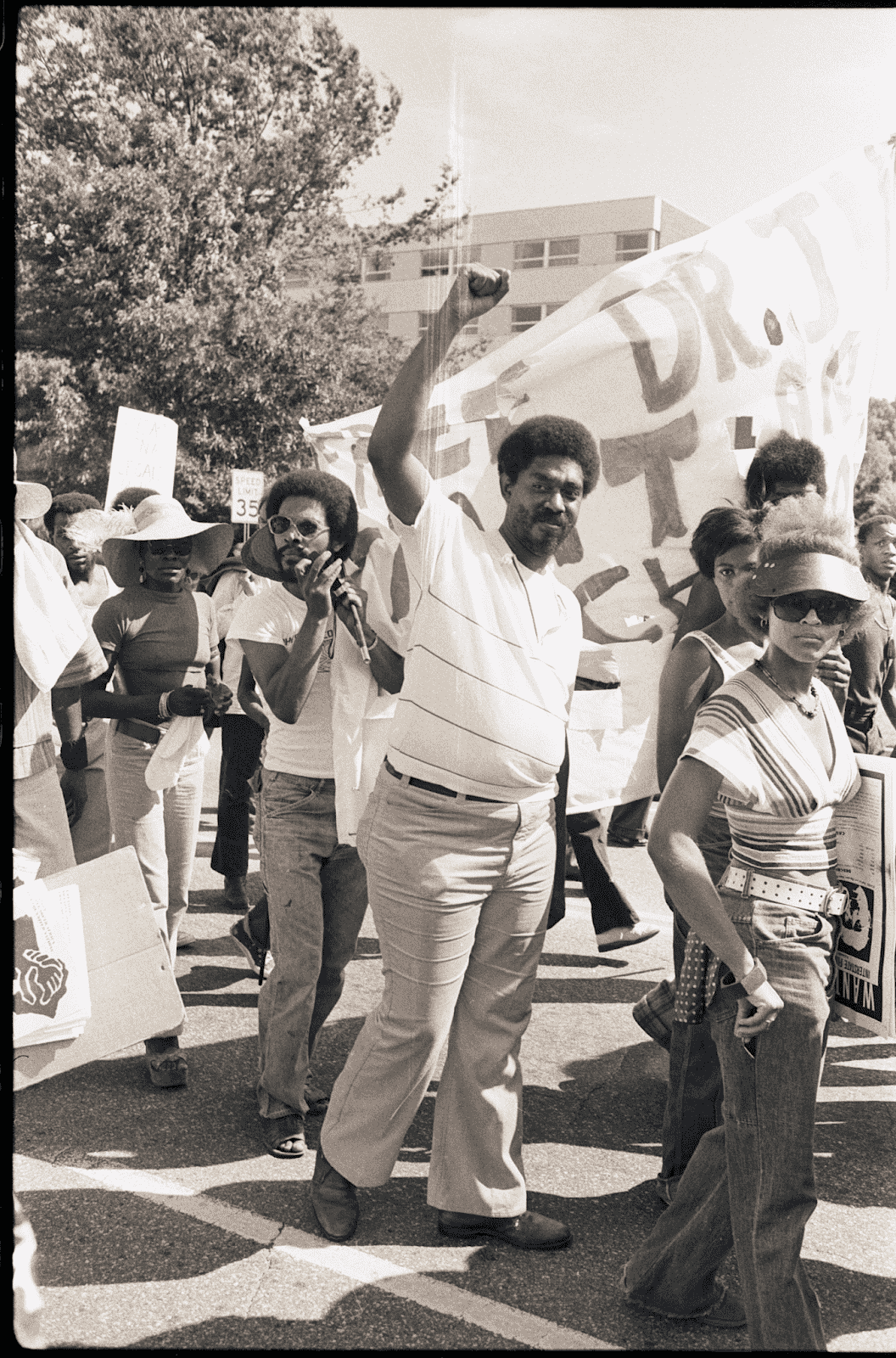
Protestors holding signs at protest against the death penalty, 1974.
This blog post was contributed by Katie Bushman, Special Collections Graduate Assistant.
Please note that some historical materials may contain harmful content and/or descriptions. Learn how we’re addressing it.
Fifty years ago, on July 4, 1974, 4,500 protesters marched in Raleigh near NC State University’s campus to protest against the death penalty. This historic moment was captured by student Ed Caram, whose photographs are being digitized and added to the Special Collections Research Center’s Rare and Unique Digital Collections website.
In 1974, the North Carolina legislature enacted a mandatory death penalty statute for all capital crimes. This removed the ability of the jury to recommend a sentence of life imprisonment, instead automatically sentencing anyone convicted of a capital crime to death. In April of that year, the statute was amended to exclude burglary and arson from the list of capital crimes, though this did not alter the sentences of anyone already on death row under the previous law, as reported by the News and Observer on July 29, 1974.
According to the News and Observer, at the time of the march, North Carolina had 45 incarcerated people on death row at Central Prison in Raleigh. This number was the largest in the country, accounting for one third of all people on death row nationwide. The majority of people on death row were African American, making the issue of the death penalty a civil rights issue for protestors on the march.
The Independence Day march in Raleigh was organized by the National Alliance against Racist and Political Repression and led by the alliance’s co-chairperson, civil rights leader Angela Davis. According to the News and Observer, Davis addressed the crowd during the march, saying, “They must be trembling in Washington to see us holding hands today. Black, brown, red, yellow and white. Trade unionists, nationalists, and progressive independents. And yes, ministers and Communists.” [For additional research, the State Archives of North Carolina holds some materials related to Angela Davis’s involvement in the July 4th protest near campus.]
The march began at Memorial Auditorium downtown, then marched past the State Capitol and down Morgan Street, past the Central Prison where the men on death row were held. Protesters then walked down Hillsborough Street to Pullen Park, near the NC State campus, and ended with a picnic and a concert near Pullen Park. Ed Caram photographed the protest as it passed down Hillsborough Street, taking pictures of students and community members participating in the march.
Caram also captured the significant police and counter-protester presence at the march. His photographs depict a long row of city policemen standing at attention as the protesters walked down Hillsborough St. In their July 5 coverage of the event, the News and Observer reported that over 1,500 law enforcement officers were called in anticipation of the protest, including 1,000 National Guardsmen who were on standby at the fairgrounds but were never called into the city. The local newspaper reported that the protest was peaceful, and there were no arrests.
As depicted in some of the newly digitized photographs, the protest was picketed by the Ku Klux Klan, the American Nazi Party, and the segregationist group the Rights of White People (ROWP). A group of ROWP counter-protesters were stationed behind the police line on Hillsborough, and Caram captured images of picketers holding up Nazi salutes and signs reading, “I’m for the death penalty,” “Commies go home,” and “Civil Rights for Whites.”
Ed Caram was an Air Force veteran who attended NC State as part of the G.I. Bill from 1969-1975. During his time at the university, he was a student photographer for the Technician and captured images of historic athletic victories, student protests, campus life, and aerial views of campus. A portion of Caram’s 8,000 photographs have been digitized and are available to view online.
If you have any questions or are interested in viewing Special Collections materials, please contact us at library_specialcollections@ncsu.edu or submit a request online. The Special Collections Research Center is open by appointment only. Appointments are available Monday–Friday, 9am–6pm and Saturday, 1pm–5pm. Requests for a Saturday appointment must be received no later than Tuesday of the same week.
Carroll, Ginny. “4,000 March Here in Peaceful Protest.” The News and Observer. July 5, 1974. https://www.newspapers.com/image/653221535/
Carroll, Ginny. “N.C. Inmates Take Case to High Court.” The News and Observer. July 29, 1974. https://www.newspapers.com/image/653110616/
Davis, Angela. “March to Raleigh: Death Penalty Protest Set.” The News and Observer. January 10, 1974. https://www.newspapers.com/image/653117697/
Horvith, Paul. “Davis Sees New Efforts Against Racism in N.C.” The News and Observer. July 7, 1974. https://www.newspapers.com/image/653222690/
“North Carolina." Death Penalty Information Center. Accessed June 21, 2024. https://deathpenaltyinfo.org/state-and-federal-info/state-by-state/north-carolina
Stith, Pat. “Police, Patrol Keep Close Eye on March.” The News and Observer. July 5, 1974. https://www.newspapers.com/image/653221535/